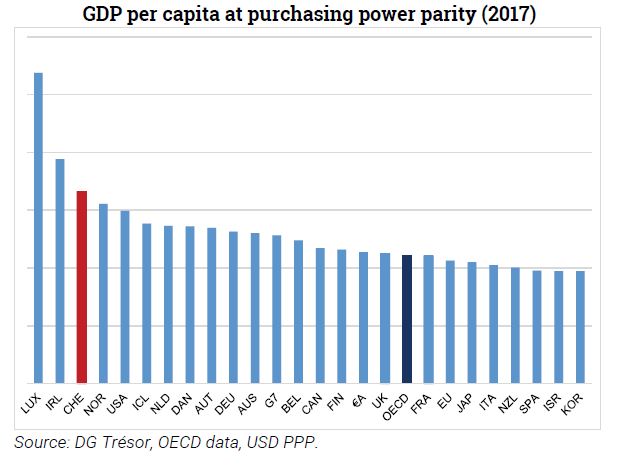Trésor-Economics No. 246 - What lessons can be drawn from Switzerland's high standard of living?
The high standard of living in Switzerland compared to OECD countries is due to a high level of integration into the labour market and a high working time for full-time employees. Switzerland also benefits from the agreement on the free movement of persons with the European Union, which has facilitated the reception of qualified personnel. Finally, the contribution to value creation of the manufacturing and financial sectors is major, due to their productivity and size.
Switzerland, the world's 20th largest economy by gross domestic product (GDP), is characterized by long-term stable growth, one of the lowest unemployment rates among OECD countries, a structural current account surplus, an educational system that integrates young people into the labor market, and an efficient R&D ecosystem. This prosperity is evidenced in one of the world's highest living standards, with the third-highest GDP per capita at purchasing power parity (PPP) in the OECD (chart).
The difference in GDP (PPP) per capita between Switzerland and France is explained mostly by a more intensive use of the labor factor. Three mechanisms are at work: Switzerland's very high employment rate, including for "seniors" aged 65 or over, cross-border commuters (frontier workers), and far higher annual hours worked by those in full-time employment. Levels of skills and qualifications, however, are equivalent in both countries.
Measured at the aggregate level, hourly productivity in PPP is similar in both countries. A more detailed analysis by sector, however, shows that sectors exposed to international competition (manufacturing and financial services) make a greater contribution to value creation in Switzerland. This difference is explained by a composition effect, as employment is more concentrated in those sectors, and by higher productivity in those sectors than the national average. The financial services sector thus makes a substantial contribution to Switzerland's higher living standard. Overall, Switzerland's production base is characterized by stronger specialization, more export orientation, and higher pricing power (linked, among other factors, to the concentration of activities in the high range level).
Furthermore, the stock of foreign direct investment per capita is ten times higher in Switzerland than in either France or Germany. Even if some FDI flows are attributable to companies that conduct only a small fraction of their commercial activity in Switzerland, they do stimulate production and employment.
Between 1997 and 2017, the gap in living standards between France and Switzerland widened by roughly 9 points. Two trends contributed to the process. First, Switzerland benefited from the agreement with the European Union on the free movement of persons, which facilitated the entry of qualified personnel from EU countries and greater employment of non-residents. Second, for full-time employees, growth in productivity per job in France was moderated by the reduction in statutory working hours.
